Super fluffy donuts, filled with creamy vanilla Bavarian cream, and rolled in vanilla sugar, I’m pretty sure these Bavarian Cream donuts are the best thing I’ve ever made. This recipe is a relatively small batch and only makes 6 donuts but if you want to make a full dozen, double the filling and use this Krapfen recipe for the dough.
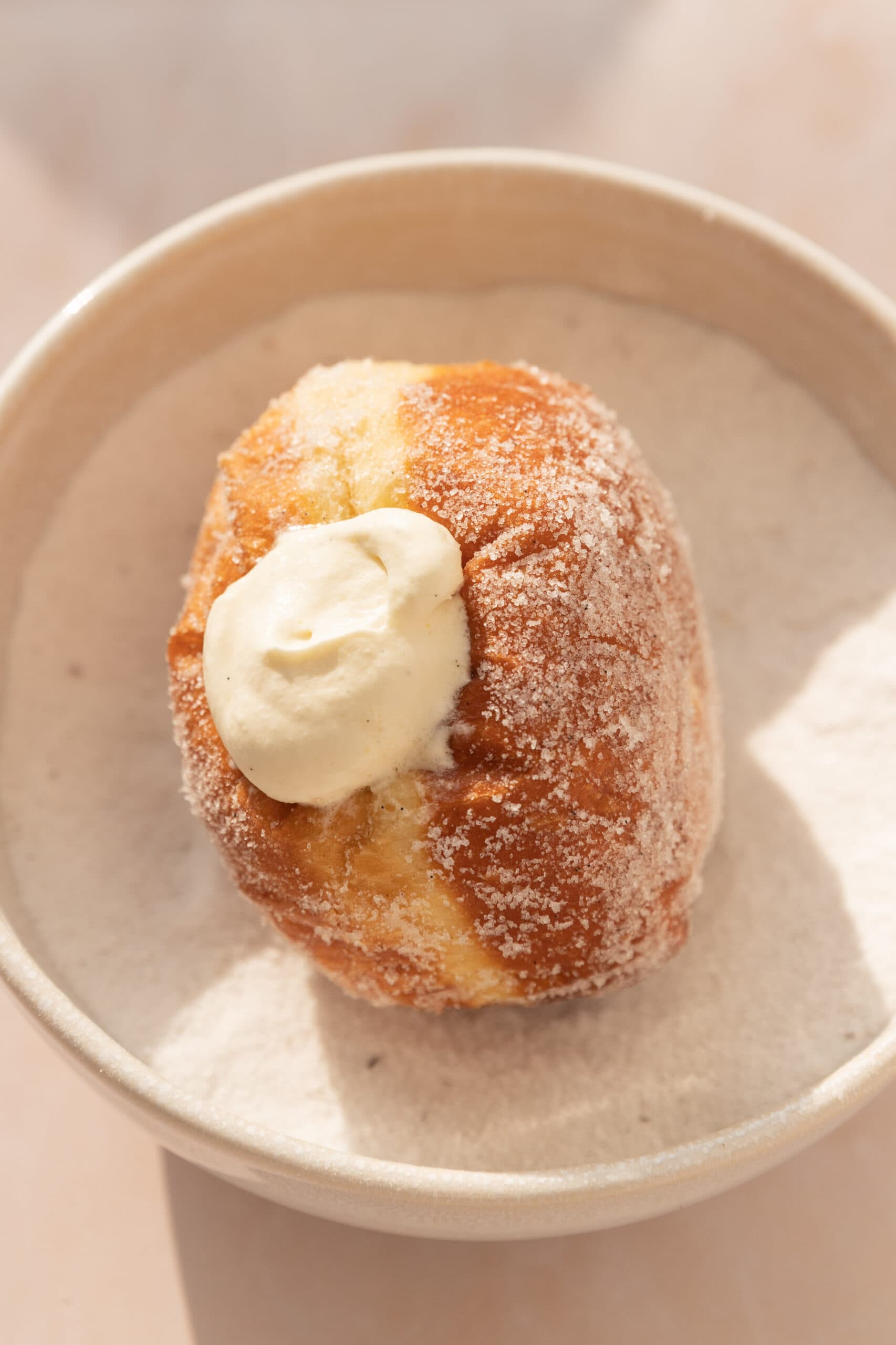
What is a Bavarian Cream Donut?
Bavarian Cream Donuts are simply, light and fluffy donuts filled with bavarian cream. Bavarian cream is a cream made from custard folded with whipped cream. When Bavarian cream is made traditionally it has gelatin in it and slightly less whipped cream. However, these don’t need the gelatin as it won’t have time to set in the donuts, and the extra whipped cream stiffens the filling.
Instant Yeast vs. Active Dry Yeast?
Either yeast can be used in this recipe and the amount will stay the same for both. Both can be whisked in with the dry ingredients and neither need to be bloomed ahead of time for this recipe. However, if you are using active dry yeast be prepared for it to take a little longer to proof.
How do I know when the dough has been kneaded long enough?
This is quite a soft dough which keeps the donuts nice and fluffy but it also means it will take a bit longer for it to be fully kneaded. The dough should pull away from the sides of the bowl when kneading on low speed. The dough should also pass the windowpane test. The window pane test means that when you tear off a section of dough and stretch it gently, it should stretch until light passes through before tearing.
Can these be made in advance?
I don’t recommend making any donuts in advance because the fried dough tastes best fresh. But, the custard can be made the day before and if necessary, you can make the dough, shape the donuts, and place them, covered, in the fridge overnight. Then let them proof at room temperature the next day before frying.
What kind of oil should be used to fry Donuts?
Any neutral oil with a high smoke point works well for frying donuts. I recommend vegetable oil, canola oil, or avocado oil.
Additional Recipes to try:
Tips for making Bavarian Cream Donuts
- Make sure all dough ingredients are at room temperature. For more tips on yeasted dough, refer to this Yeasted Dough Guide.
- When dividing and shaping the rolls, always start with the same portion of dough. This means that the first piece that is divided, is also the first to be shaped in a ball.
- Once shaped, place the rolls on lightly floured surface. This makes it easy to handle them once they are soft and fluffy and allows them to be easily transferred into the fry oil.
- It is important to fry the donuts between 340 F and 350 F. I find that 350 F is the best temperature that allows the center to be fully cooked without the outside burning. To keep the oil at the temperature be sure to keep a thermometer in the oil and I recommend heating it to 350 F. Then add in the donuts and the temperature will drop to around 340F.
- Roll the donuts immediately in the sugar but allow them to cool before filling with the Bavarian Cream.
- If the bavarian cream filling seems to soft, whip in a little powdered sugar and allow it to sit in the fridge for a little. Re-whip briefly if needed.
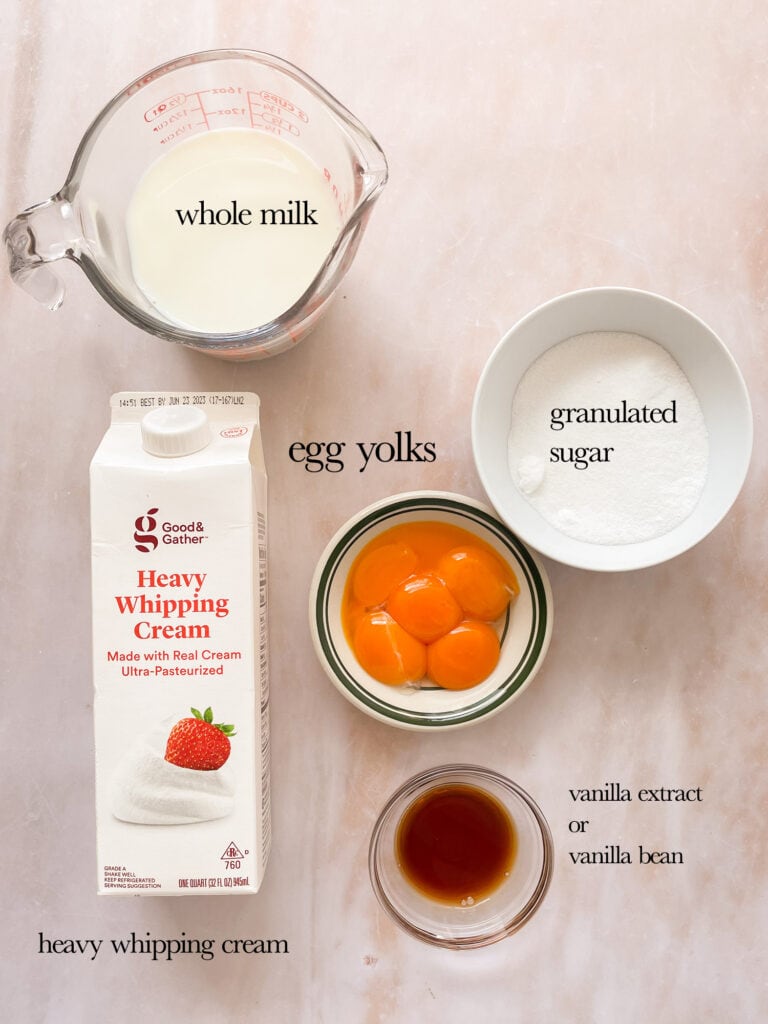
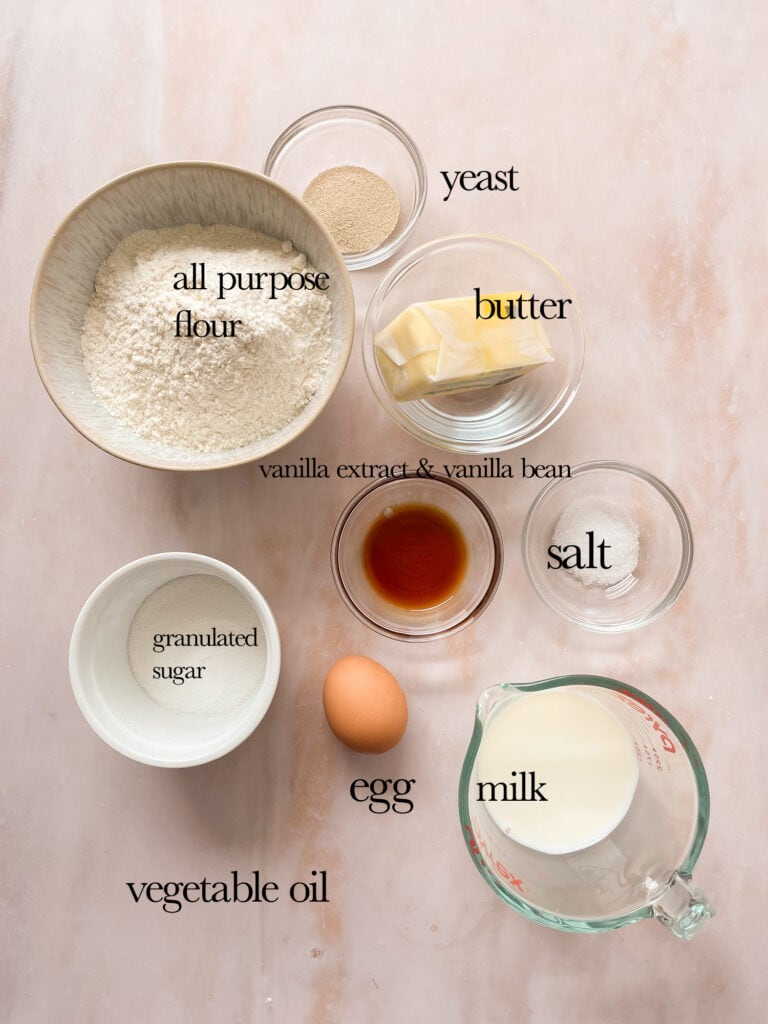
Ingredients
Bavarian Cream
- Whole Milk: Milk is the main base for the custard. You can use skim milk too but it won’t be as creamy. For and extra creamy filling, replace the milk with heavy cream.
- Vanilla Extract or Vanilla Bean: If you feel like it and have one on hand, vanilla bean adds delicious flavor to the custard. If not, vanilla extract added at the end will create a similar taste!
- Egg yolks: Egg yolks should come from large eggs, they do not need to be at room temperature for this custard.
- Granulated Sugar: Granulated sugar adds sweetness and thickens the custard.
- Butter: I don’t usually add butter to my bavarian cream (hence why it isn’t pictured) but due to the lack of gelatin, it helps to thicken the custard.
- Heavy Cream: Heavy cream makes the filling light and fluffy when whipped to stiff peaks. The cream should be cold before whipping.
Donuts
- All Purpose Flour: Any all purpose flour will work for these! I have not yet tried any other flours with this recipe.
- Sugar: This recipe uses granulated sugar in the dough as well as on the outside for sweetness and texture.
- Yeast: In this recipe, either active dry or instant yeast will work but I prefer instant.
- Milk: The donuts use milk as the liquid in the dough; however, they will also work with non-dairy milks such as almond or light coconut milk.
- Eggs: I use one standard large egg from the store, it should be at room temperature.
- Butter: The butter adds moisture to the donuts as well as makes them softer! It’s important that the butter is at room temperature, otherwise it will cool down the dough and be difficult to incorporate.
- Vanilla extract & Vanilla Bean: I like to add a teaspoon of vanilla to give the buns extra flavor. The vanilla bean is for mixing with the granulated sugar for rolling the donuts. The vanilla bean is optional, you can always leave the sugar plain or add cinnamon or any other spice you want!
- Salt: Salt balances out the sweetness and enhances the flavor of the donuts.
- Vegetable Oil: Vegetable oil or Canola oil are used to fry the donuts, I believe avocado oil may work as well but I haven’t tested it.
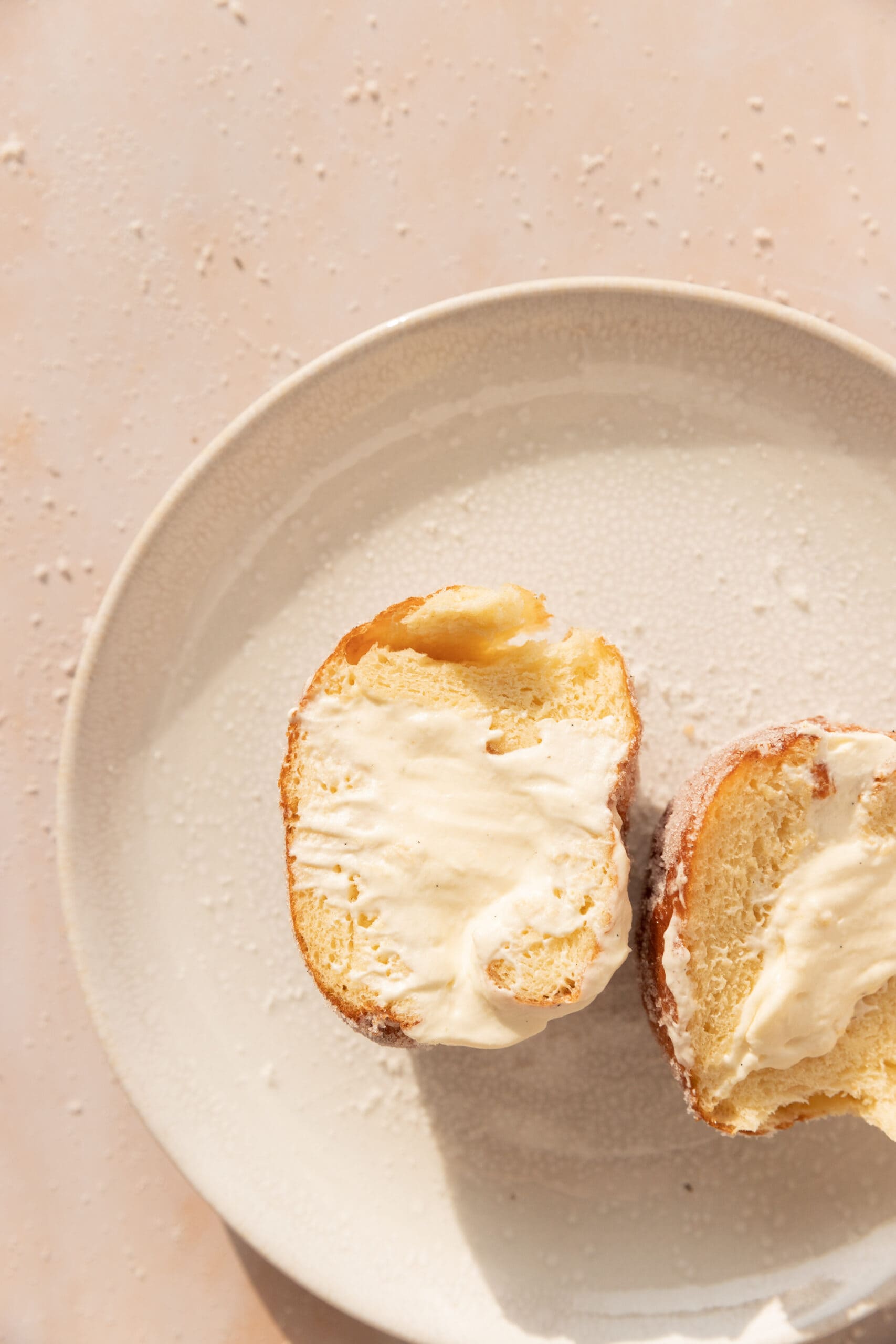
How to make Cream Donuts
Vanilla Bean Custard
- In a small sauce pot, pour in the milk along with the scrapings from the inside of the vanilla bean. If using vanilla extract, wait to add it. Heat over medium heat, stirring frequently until steaming.
- In a separate bowl, whisk the egg yolks and sugar together. Place on a damp cloth nearby the pot.
- Whisking the egg yolk mixture constantly, once the milk is steaming, turn the heat under the milk to low and use a ladle to slowly pour the warm vanilla milk into the eggs. Do this until half of the milk has been added into the egg yolks. This will temper the eggs so they won’t curdle as easily.
- Reverse the process and now while whisking the remaining vanilla milk, pour in the tempered egg mixture.
- Return to medium low heat and stir constantly but gently with a rubber spatula, scraping the sides and bottom of the pot until the surface bubbles disappear.
- Once cooked and slightly thickened, pour the custard through a fine mesh sieve into a clean bowl. Whisk in the butter and if using vanilla extract, whisk it in now.
- Place a sheet of plastic wrap onto the surface of the custard and leave it to cool to room temperature. Then store in the fridge until cold.
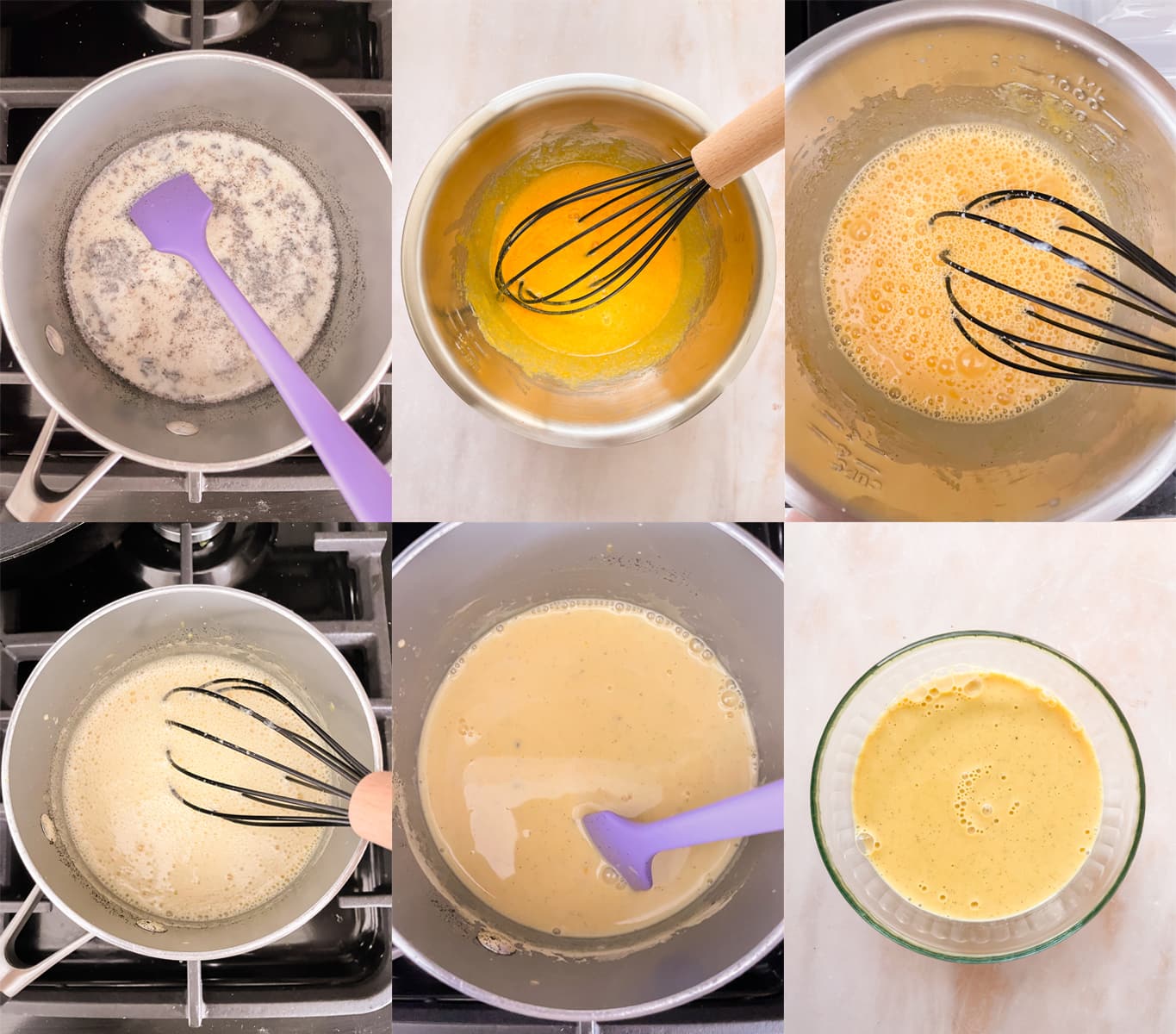
Make the dough
- Start by warming the milk until it is just warm to the touch – it should not exceed 100 degrees F.
- In the bowl of a stand mixer, add in the flour, yeast, and sugar. Then whisk it together by hand.
- Add in the warmed milk, egg, butter, salt and vanilla extract. Knead the mixture with the dough hook on the stand mixer for 15-20 minutes on low speed until it is smooth and the bowl is clean.
- Remove the dough and shape it into a ball. Lightly grease the mixing bowl that you were just using and place the ball of dough back in. Then cover the bowl with a towel or plastic and place somewhere warm for 30-45 min. The dough should double in size.
- Once doubled in size, it is time to shape the donuts. *If you have an electric stove, start heating the oil now in a large heavy bottomed pot, as it will take longer.
- Divide the dough into 6 equal weight portions.
- Working with one portion at a time. First flatten slightly into a disk, then working in a clockwise direction, bring the edges into the center of the disk.
- Shape your hand into a claw over the ball of dough with the smooth side face up. Roll the ball around in your hand on a clean work surface to create tension on the dough and seal the seem on the bottom of the ball.
- Place the rolls onto a lightly floured lined baking sheet and cover with a sheet of plastic wrap. Place somewhere warm to rise.
- If using a gas stove, heat the oil in a large heavy bottomed pot with a candy thermometer fitted to the side, over medium heat to 350 F.

Fry the donuts
- If making vanilla sugar, scrape the insides of a vanilla bean into a bowl with the sugar for rolling and stir to combine. If your vanilla bean has dried out, grind it down in a mortar and pestles and then add the sugar. Sift out any bits of vanilla bean.
- Place a wire rack on a baking sheet and lay 2 layers of paper towel on top of the rack.
- Once the rolls are proofed, use a slotted spoon or a spider to lower the proofed dough into the hot oil. Don’t fry more than 3 at a time to avoid lowering the temperature more than 10 degrees.
- Fry them on each side for 1.5 minutes. Use the spoon to carefully flip them over by pressing down on one side. Then, fry for another 1.5 minutes.
- Once 3 minutes are up use the slotted spoon to remove the donuts from the oil and place on the paper towel lined rack.
- Allow the oil to reheat to 350 F before adding in another batch of donuts.
- Once the next batch is in the oil, roll the first batch in the vanilla sugar and place on a separate wire rack to cool.
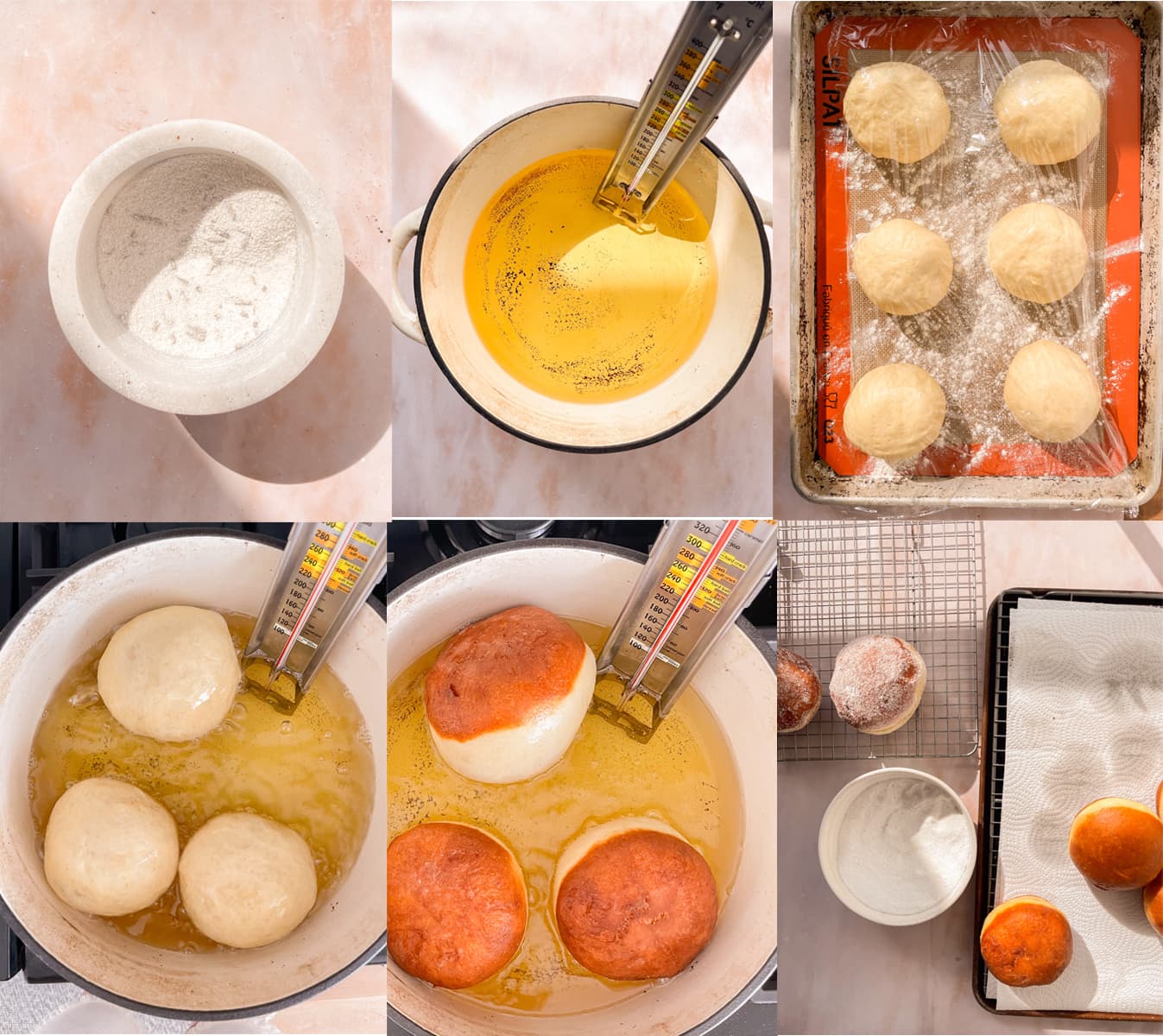
Make Bavarian Cream
- While the donuts cool, use an electric mixer whip the cream on high to stiff peaks. Add in the cooled custard and whip again until stiff peaks form.
- Place in the fridge to keep it cool until ready to use.
- If needed, rewhip the filling when ready to use.
- Once the donuts have cooled, use a small knife to poke a hole in the side of each krapfen.
- Fill a piping bag with the bavarian cream and pipe it into each donut until no more will fit.
- Enjoy immediately!
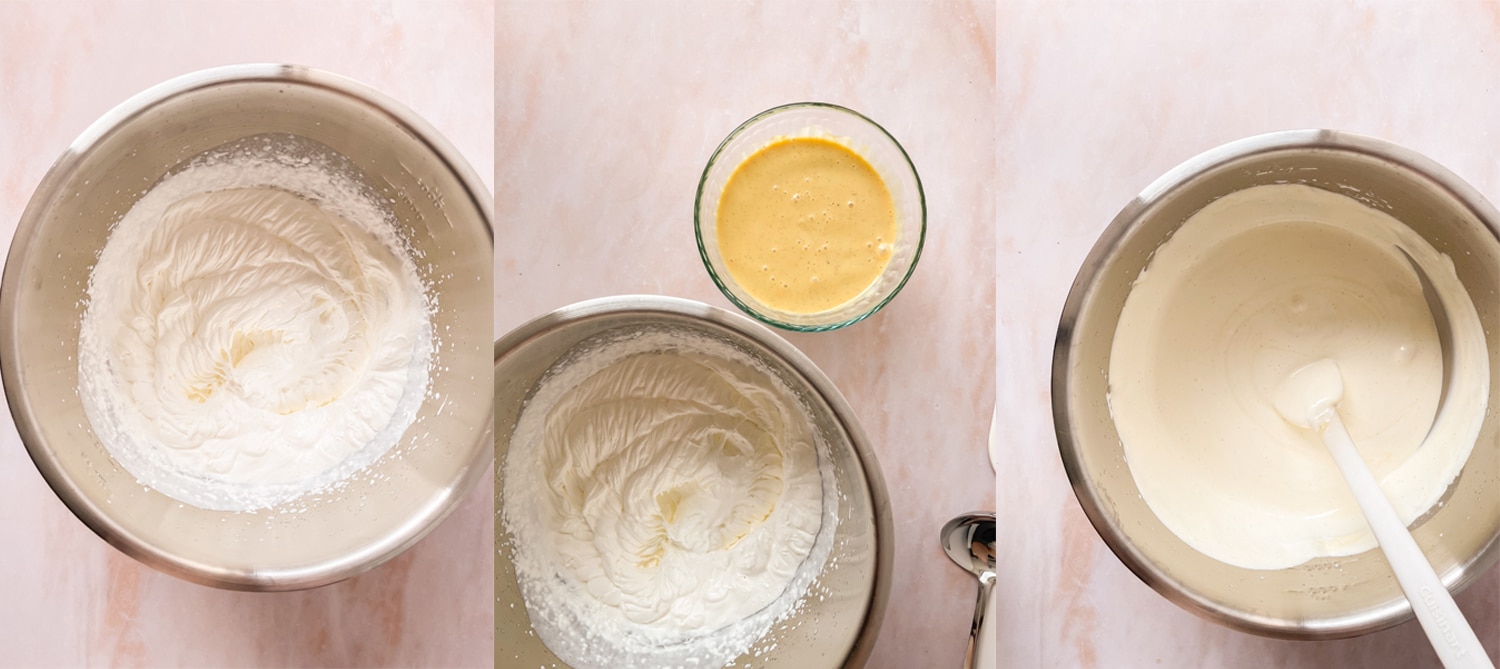

Bavarian Cream Donuts
Equipment
- Stand Mixer
- Sauce Pot
Ingredients
Bavarian Cream
- 120 milliliters whole milk
- 1 vanilla bean or 1 teaspoon vanilla extract
- 2 egg yolks large eggs
- 30 grams granulated sugar
- 2 tablespoons butter cut into 2 smaller pieces
- 200 milliliters heavy cream cold, more as needed to make a stiff filling
Donuts
- 250 grams all purpose flour
- 30 grams granulated sugar
- 7 grams instant yeast
- 125 milliliters milk
- 1 egg large, room temperature
- 20 grams butter softened
- 1 teaspoon vanilla extract
- 1/2 teaspoon salt
Frying
- 1 liter vegetable oil
Coating
- 75 grams granulated sugar
- 1 vanilla bean
Instructions
Vanilla Bean Custard
- In a small sauce pot, pour in the milk along with the scrapings from the inside of the vanilla bean. If using vanilla extract, wait to add it. Heat over medium heat, stirring frequently until steaming.
- In a separate bowl, whisk the egg yolks and sugar together. Place on a damp cloth nearby the pot.
- Whisking the egg yolk mixture constantly, once the milk is steaming, turn the heat under the milk to low and use a ladle to slowly pour the warm vanilla milk into the eggs. Do this until half of the milk has been added into the egg yolks. This will temper the eggs so they won't curdle as easily.
- Reverse the process and now while whisking the remaining vanilla milk, pour in the tempered egg mixture.
- Return to medium low heat and stir constantly but gently with a rubber spatula, scraping the sides and bottom of the pot until the surface bubbles disappear.
- Once cooked and slightly thickened, pour the custard through a fine mesh sieve into a clean bowl. Whisk in the butter, and if using vanilla extract, whisk it in now.
- Place a sheet of plastic wrap onto the surface of the custard and leave it to cool to room temperature. Then store in the fridge until cold.
Donut Dough
- Start by warming the milk until it is just warm to the touch – it should not exceed 100 degrees F.
- In the bowl of a stand mixer, add in the flour, yeast, and sugar. Then whisk it together by hand.
- Add in the warmed milk, egg, butter, salt and vanilla extract. Knead the mixture with the dough hook on the stand mixer for 15-20 minutes on low speed until it is smooth and the bowl is clean.
- Remove the dough and shape it into a ball. Lightly grease the mixing bowl that you were just using and place the ball of dough back in. Then cover the bowl with a towel or plastic and place somewhere warm for 30-45 min. The dough should double in size.
- Once doubled in size, it is time to shape the donuts. *If you have an electric stove, start heating the oil now in a large heavy bottomed pot, as it will take longer.
- Divide the dough into 6 equal weight portions.
- Working with one portion at a time. First flatten slightly into a disk, then working in a clockwise direction, bring the edges into the center of the disk.
- Shape your hand into a claw over the ball of dough with the smooth side face up. Roll the ball around in your hand on a clean work surface to create tension on the dough and seal the seem on the bottom of the ball.
- Place the rolls onto a lightly floured lined baking sheet and cover with a sheet of plastic wrap. Place somewhere warm to rise.
- If using a gas stove, heat the oil in a large heavy bottomed pot with a candy thermometer fitted to the side, over medium heat to 350 F.
Fry the donuts
- If making vanilla sugar, scrape the insides of a vanilla bean into a bowl with the sugar for rolling and stir to combine. If your vanilla bean has dried out, grind it down in a mortar and pestles and then add the sugar. Sift out any bits of vanilla bean.
- Place a wire rack on a baking sheet and lay 2 layers of paper towel on top of the rack.
- Once the rolls are proofed, use a slotted spoon or a spider to lower the proofed dough into the hot oil. Don't fry more than 3 at a time to avoid lowering the temperature more than 10 degrees.
- Fry them on each side for 1.5 minutes. Use the spoon to carefully flip them over by pressing down on one side. Then, fry for another 1.5 minutes.
- Once 3 minutes are up use the slotted spoon to remove the donuts from the oil and place on the paper towel lined rack.
- Allow the oil to reheat to 350 F before adding in another batch of donuts.
- Once the next batch is in the oil, roll the first batch in the vanilla sugar and place on a separate wire rack to cool.
Bavarian Cream
- While the donuts cool, use an electric mixer whip the cream on high to stiff peaks. Add in the cooled custard and whip again until stiff peaks form.
- Place in the fridge to keep it cool until ready to use.
- If needed, rewhip the filling when ready to use.
- Once the donuts have cooled, use a small knife to poke a hole in the side of each krapfen.
- Fill a piping bag with the bavarian cream and pipe it into each donut until no more will fit.
- Enjoy immediately!
Notes
- Make sure all dough ingredients are at room temperature. For more tips on yeasted dough, refer to this Yeasted Dough Guide.
- When dividing and shaping the rolls, always start with the same portion of dough. This means that the first piece that is divided, is also the first to be shaped in a ball.
- Once shaped, place the rolls on lightly floured surface. This makes it easy to handle them once they are soft and fluffy and allows them to be easily transferred into the fry oil.
- It is important to fry the donuts between 340 F and 350 F. I find that 350 F is the best temperature that allows the center to be fully cooked without the outside burning. To keep the oil at the temperature be sure to keep a thermometer in the oil and I recommend heating it to 350 F. Then add in the donuts and the temperature will drop to around 340F.
- Roll the donuts immediately in the sugar but allow them to cool before filling with the Bavarian Cream.
- If the bavarian cream filling seems to soft, whip in a little powdered sugar and allow it to sit in the fridge for a little. Re-whip briefly if needed.
Nutrition
This page may contain affiliate links. This means that if you click on one of the product links above and complete a purchase, I’ll receive a small commission at no extra cost to you. I will never place a link nor make a recommendation on a product or service that I don’t love or use personally. Read our privacy policy here. Thank you for supporting Red Currant Bakery.
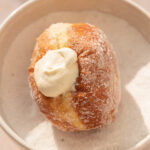
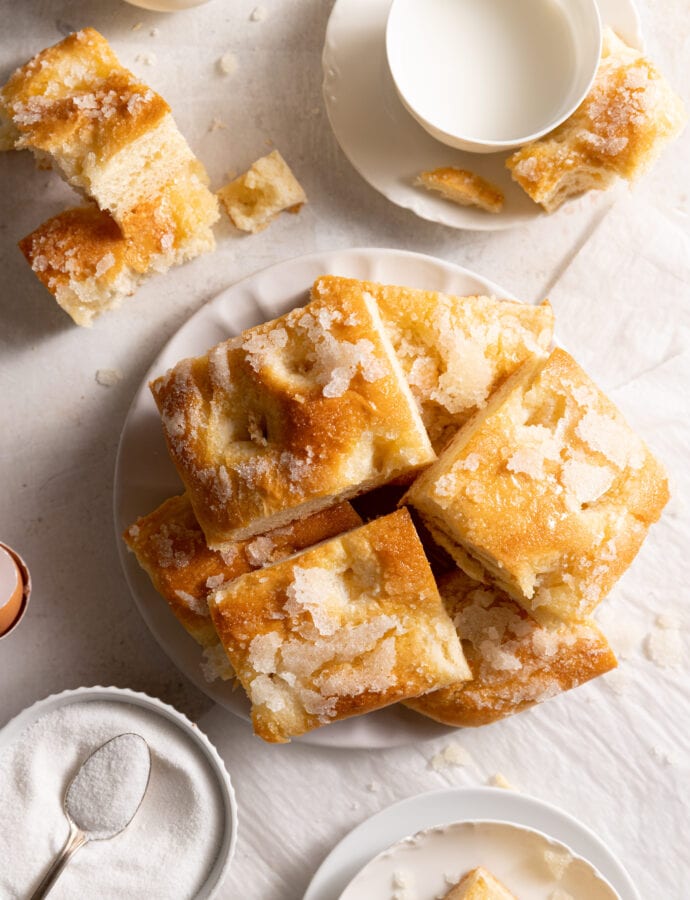
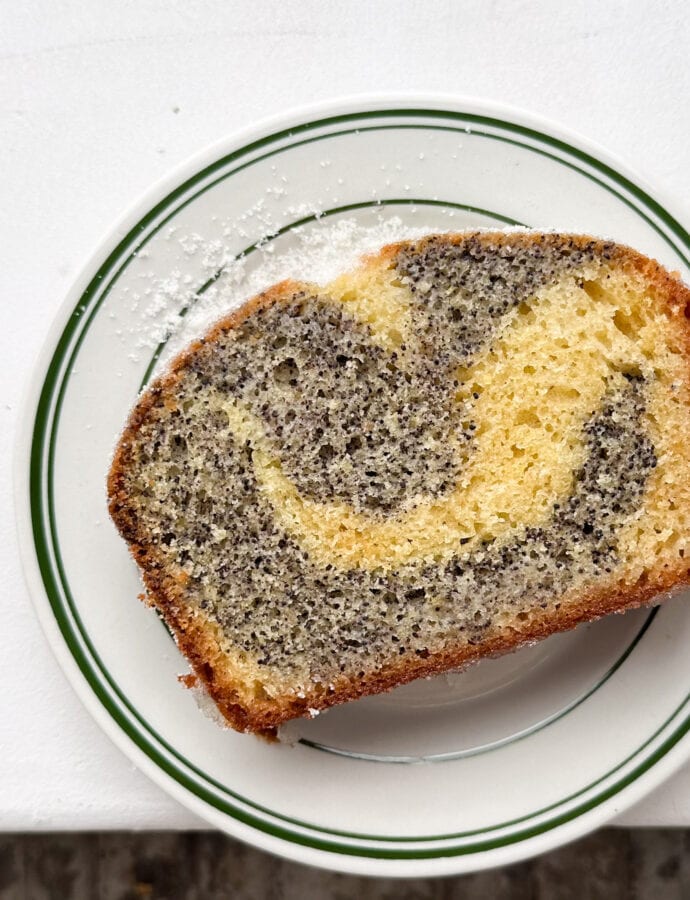
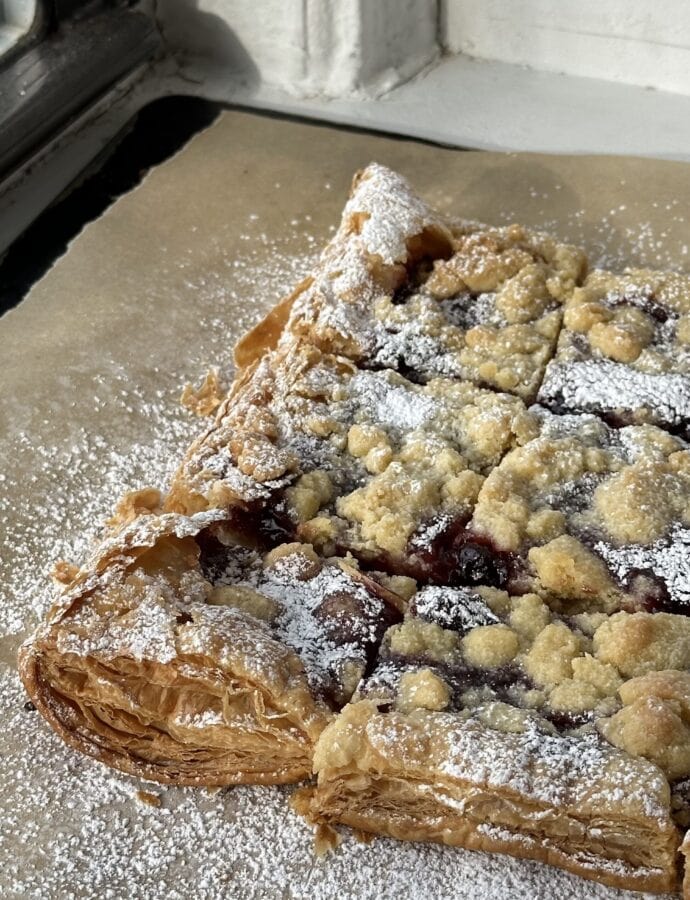
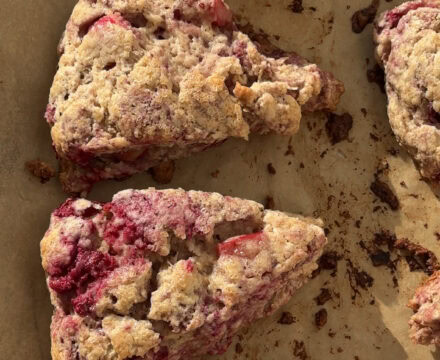
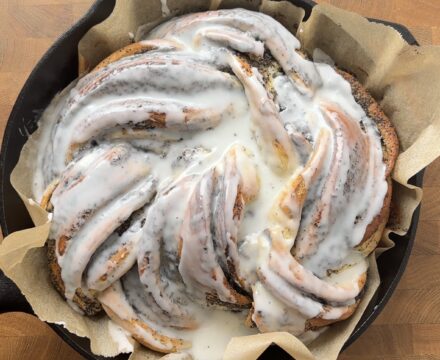
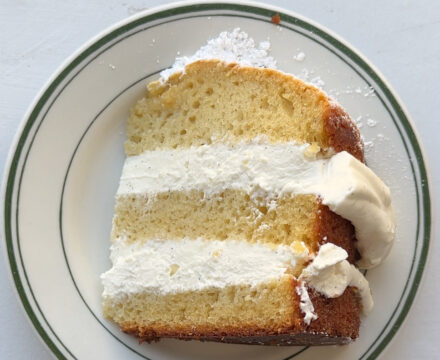

Could I suggest that all the ingredients be captured in grams as well as volume measurements. It is very helpful when portioning if you’re making more than one batch or, for example, in this recipe where you want equal portions for the Donuts. Converting ml to grams is easy for water but not so much when you are dealing with other liquids – milk, buttermilk, oil. Thanks much for all the recipes you do. Love them!!
Hi Brian thanks so much for your note! I completely understand, I like to post in grams and ml for accuracy purposes as well as scaling a recipe because it makes the math easier. For portioning the donuts, I recommend weighing the finished dough and then dividing by how many donuts you want – that will be the most accurate as different eggs will vary in weight as well.